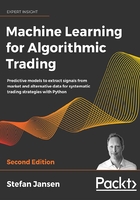
From inference to prediction
As the name suggests, linear regression models assume that the output is the result of a linear combination of the inputs. The model also assumes a random error that allows for each observation to deviate from the expected linear relationship. The reasons that the model does not perfectly describe the relationship between inputs and output in a deterministic way include, for example, missing variables, measurement, or data collection issues.
If we want to draw statistical conclusions about the true (but not observed) linear relationship in the population based on the regression parameters estimated from the sample, we need to add assumptions about the statistical nature of these errors. The baseline regression model makes the strong assumption that the distribution of the errors is identical across observations. It also assumes that errors are independent of each other—in other words, knowing one error does not help to forecast the next error. The assumption of independent and identically distributed (IID) errors implies that their covariance matrix is the identity matrix multiplied by a constant representing the error variance.
These assumptions guarantee that the OLS method delivers estimates that are not only unbiased but also efficient, which means that OLS estimates achieve the lowest sampling error among all linear learning algorithms. However, these assumptions are rarely met in practice.
In finance, we often encounter panel data with repeated observations on a given cross section. The attempt to estimate the systematic exposure of a universe of assets to a set of risk factors over time typically reveals correlation along the time axis, in the cross-sectional dimension, or both. Hence, alternative learning algorithms have emerged that assume error covariance matrices that are more complex than multiples of the identity matrix.
On the other hand, methods that learn biased parameters for a linear model may yield estimates with lower variance and, hence, improve their predictive performance. Shrinkage methods reduce the model's complexity by applying regularization, which adds a penalty term to the linear objective function.
This penalty is positively related to the absolute size of the coefficients so that they are shrunk relative to the baseline case. Larger coefficients imply a more complex model that reacts more strongly to variations in the inputs. When properly calibrated, the penalty can limit the growth of the model's coefficients beyond what is optimal from a bias-variance perspective.
First, we will introduce the baseline techniques for cross-section and panel data for linear models, as well as important enhancements that produce accurate estimates when key assumptions are violated. We will then illustrate these methods by estimating factor models that are ubiquitous in the development of algorithmic trading strategies. Finally, we will turn our attention to how shrinkage methods apply regularization and demonstrate how to use them to predict asset returns and generate trading signals.